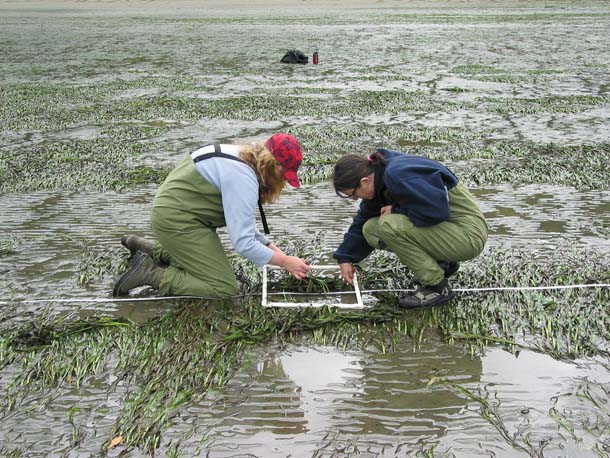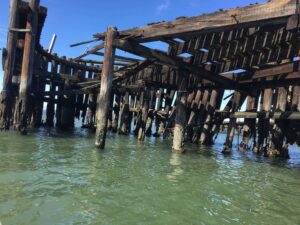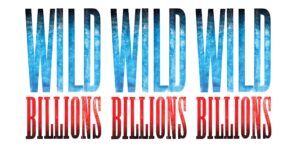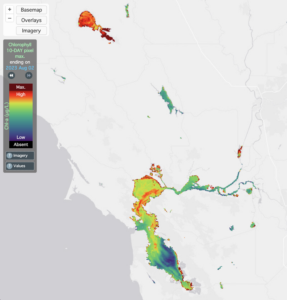Noble is an old-fashioned word, but it comes to mind as I watch six humans in wet suits dive into five feet of Bay to plant 100 shoots of eelgrass. They cannot see what they are doing–too much sediment clouds the water. They must work encased in rubber and engulfed in icy liquid. They must half-swim, half-crawl, half-stumble to their work sites–the shallow, subtidal areas of the Bay where the layer of foot-sucking mud may be just as deep as the water. It always seems to be the crack of dawn, or some ungodly hour determined by low tide. If they don’t strap on weight belts, their wet suits balloon up, forcing two divers to hold a third down to do the fine underwater work. And if the wind picks up before the roots can grab hold, a big wave might just rip their plantings of this silvery-green native sea grass right out of the mud.
But it is not the difficulty of this work, nor the uncertainty of the outcome, nor even the age-old nurturing task of planting something that makes this noble. It’s the ambition of it. The idea that not only can we undo a long history of human impacts and restore the environment, but we can do it underwater, in a bay busy with oil tankers, laced with PCBs, bedeviled by alien species, and crowded by 46 cities.
“It’s a bold thing to try to do,” says Chela Zabin, one of dozens of scientists and resource managers who’ve helped forge a vision of how to protect and restore the part of the Bay that lies underwater–a diverse ecosystem largely hidden from human view.
Their vision, captured in a 125-page report to be published this winter, is the product of a collaborative regional effort called the San Francisco Bay Subtidal Habitat Goals Project. “We were asked to take a big, long-term view, and not to limit ourselves by thinking that the Bay is so urbanized there’s not much that can be done to make it ecologically whole,” says Zabin, a marine biologist with UC Davis and the Smithsonian Environmental Research Center. “A lot of people think the Bay is toast. But working in it, I’ve been pleasantly surprised to find nice healthy oyster and eelgrass beds, places just crawling with baby crabs.”
- At low tide, Kathy Boyer, on the left, and Sarah Cohen, on the right, inspect eelgrass in a research plot. The Subtidal Habitat Goals include a target of more than doubling healthy beds to 8,000 acres. Photo by Jude Stalker.
This morning, at the Berkeley Marina, it seems somehow “appropriate,” as one passerby put it, that the experiment with underwater restoration should happen next to a former landfill disguised as a park. There was a time, a mere 50 years past, when the shoreline was not so pretty, and when people vewed the Bay’s shallows as an “appropriate” place to put trash, sewage, and fill for new homes. Today, locals don’t come here to dump old appliances but instead to walk by the water, inhale the salt air, and sense open space.
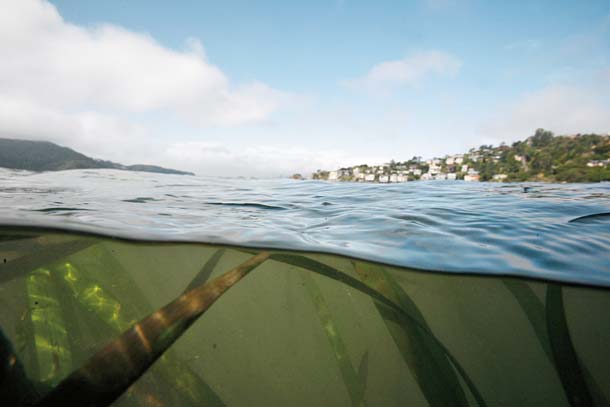
- Eelgrass, a true flowering plant, grows in several shallow parts of the Bay. Photo: Lorenz-Avelar.com
They also come to plant eelgrass. The six divers make quick work of it. At 6:45 a.m., they load a wheelbarrow and hand truck with a few dozen lengths of bamboo and white PVC pipe, a cooler of live wet eelgrass, and buckets full of twist ties and burlap, then push and pull this paraphernalia a half mile along the shore. Getting down to the water’s edge is even more challenging, especially in rubber slippers. The restoration team spreads out over the riprap slope–slick at the bottom with wet algae–and passes snorkeling gear, plant materials, and tools down hand-to-hand.
Scientist Kathy Boyer of San Francisco State’s Romberg Tiburon Center has been studying eelgrass beds and experimenting with restoration techniques in the Bay for six years, and she knows what she wants and where. She points out a bunch of black sticks already in the water, set off by orange hazard buoys to warn boaters away. At the base of these sticks lie pallets stuffed with shells, the first stage of an oyster restoration project. By planting eelgrass nearby, Boyer hopes to discover if there’s synergy in the shallow water ecosystem between the native shellfish and the native plant.
Boyer’s colleague Stephanie Kiriakopolos reviews the planting method she’s developed especially for San Francisco Bay. “We have such gelatinous sediment, transplanting shoots directly doesn’t really work well. They can come loose and float away too easily,” she says. Her method involves affixing the eelgrass shoot to a bamboo stake, with the help of those twist ties, then pushing these stakes down till the roots can be buried in mud. “Some people use the two-finger technique, some people use the whole hand, but it’s all done by feel,” she says. In the early years, researchers experimented with plastic grids to hold the eelgrass in place, but these proved awkward and had to be retrieved later. “I wanted something biodegradable, easy to assemble, and cheap,” Kiriakopolos explains.
The team works in waist-high water, with two prepping the sticks and two diving and planting. Another records the process for posterity with a camera. They finish by 10 a.m. “Sometimes we have to slither like snakes through the mud, and we come out looking like creatures from the black lagoon,” says Boyer. “It’s a bit of a shock for people we meet walking back to our cars.”
Bay mud sticks like glue to wet suits, car seats, and blue jeans. Along with sand, it makes up the soft bottom, the most common of the Bay’s six main underwater habitats. The others are rocky areas, shellfish beds, artificial structures (such as bridge footings), meadows of eelgrass and submerged vegetation, and the occasional patch of macroalgae like kelp and sea lettuce.
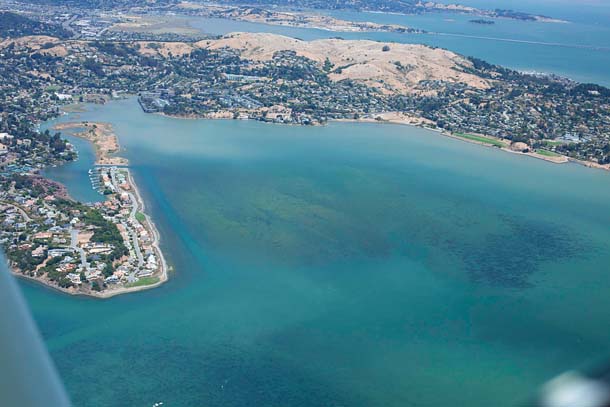
- From above, this eelgrass bed in Richardson Bay looks like a huge underwater meadow. Photo by Patrick Kelly.
To get a sense of how the Bay bottom, and what lives in it, varies, U.S. Geological Survey aquatic ecologist Jan Thompson takes graduate students out on the research vessel Polaris. At regular stations starting near Palo Alto and finishing at the confluence of the Sacramento and San Joaquin rivers near Rio Vista, the crew of this white yacht takes “grabs” of the bottom and winches them up on deck.
“At first my students just see soupy mud, then clayey mud, then a little sand, and a lot of shell from the old oyster beds. North of the Dumbarton Bridge they suddenly get a scoop full of bamboo worms, which aerate the mud by pumping water through their tubes. Here the whole texture and look of what’s coming up from the bottom changes. Now instead of pits and hummocks, my students see a shag carpet of worm tubes,” says Thompson, who has 38 years of Polaris trips under her belt and who served on the subtidal goals science review team. “Up in the central Bay we get more sand, and my students find sea pens, razor clams, and maybe a sand dollar. By the time we reach Suisun Bay, we’ve got mud coming up from the shallows and sand from the deeper channels, and all the sediment is filled with the invasive overbite clams that have changed the entire food web of the North Bay.”
Within this mosaic of underwater habitats, those most in need of protection may lie in the shallows, says Thompson. “That’s where all the action is, where all ecological functions concentrate,” she says. Here in the subtidal mudflats, there is enough light for the growth of plants, from tiny phytoplankton to larger eelgrass, that feed the estuarine food chain.

- Eelgrass, a true flowering plant, grows in several shallow parts of the Bay. Photo: Lorenz-Avelar.com
The shallows are also the area most stressed due to human activities–where dredgers clear channels and berths to prevent vessels from running aground, where cities discharge pollutants and build bay-view developments, and where invaders from other ecosystems move in on native turf and food supplies. While various public mandates seek to protect the Bay from such stresses, little effort had been systematically directed at understanding ecological functions underwater until the creation of the subtidal goals project.
“It’s a crucial part of the ecosystem,” says Natalie Cosentino-Manning, a restoration specialist for the National Oceanic and Atmospheric Administration (NOAA). “To ignore the subtidal is like ignoring the air. It’s the link between freshwater and wetland environments and the bottom of the Bay, an ecosystem sustaining an amazing variety of species that we value.”
Back in 2001, Manning was among a group of government managers who decided that the subtidal deserved just as much attention as wetlands and uplands. Since then, they have pushed to close this gap with backing from NOAA, the Bay Conservation and Development Commission (BCDC), the State Coastal Conservancy, and the public-private San Francisco Estuary Partnership. Over the next decade, they scoured old maps, conducted surveys, and experimented with restoration techniques. They then hired a top science adviser, San Francisco State’s Wim Kimmerer, to focus their decision-making process. By 2010, they’d agreed on 80 research questions, 233 recommendations, and a methodology for prioritizing future projects. The result is an “advocacy document for the resources,” says NOAA Fisheries’ Korie Schaeffer.

- Rocky areas are critical anchoring spots for oysters, seaweeds, and other species. Photo: Lorenz-Avelar.com.
In layperson’s terms, the underwater reaches of the Bay include first and foremost a lot of mud. Some came from natural erosion of local watersheds and some from the Gold Rush, when miners sprayed hillsides with hoses and thousands of tons of sediment washed into rivers and downstream. In the Bay, winds, waves, and currents stir up this sediment, clouding the water.
What else lies down there under the Bay’s turbid chop? Around islands and the Golden Gate headlands, rocks extend far down to hundreds of feet below the surface–sustaining rockfish, mussels, and a whole community of organisms equipped with suckers and tentacles that enable them to hold on in the path of strong tides and sweeping currents. Down in these deeper areas, only sand is heavy enough to settle. A mountain range of underwater dunes, in shifting waves up to 25 feet high and hundreds of feet in length, ripples through the heart of the central Bay and out the Golden Gate.
Many less natural features can also be found underwater. Surveys conducted by the San Francisco Estuary Institute and NOAA, for example, mapped 33,000 abandoned pilings standing below the lowest tidelines. Now entirely underwater, these were once places where people moored fishing boats, docked ferries, barged sand, and exchanged inland produce for sardines, salmon, or crab caught right in San Francisco Bay.
Today these pilings offer hard substrate for mussels, sea squirts, and anemones, critters that like to latch onto things. Herring find them convenient places to plaster their eggs. Unfortunately, the posts are covered with toxic creosote, making them a death trap for herring eggs. The subtidal goals recommend removal of these old pilings, as well as various abandoned vessels and other human discards cluttering the Bay floor.
But locating all that garbage is about more than just knowing where to go to pull it out. “We joke that when you see the tires and the shopping carts, you know you’re in a shallow enough spot for restoration,” says Marilyn Latta, subtidal goals project manager.
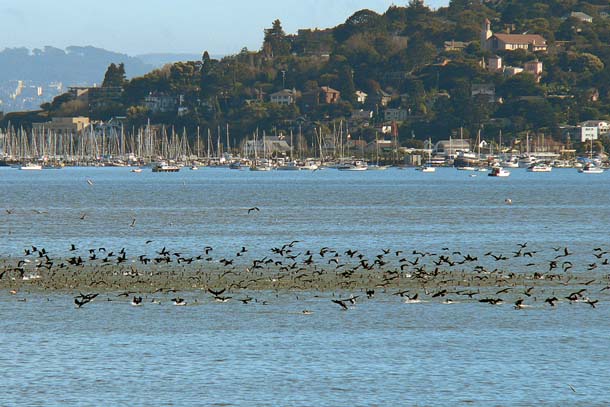
- To spot beds from a boat or from shore, watch for dozens or even hundreds of birds gathered to forage. Photo by Kerry Wilcox, Sanctuary Manager, Richardson Bay Audubon.
Choosing the right spots for restoration usually has scientists looking not only at water depth and bottom substrates, but also at where organisms like oysters and eelgrass grow naturally. Surveys by consultant Keith Merkel and Boyer’s group suggest there are currently 3,700 acres of eelgrass in the Bay–most of it in three beds. The biggest bed carpets a shoal between Point Pinole and Point San Pablo on the East Bay shore north of Richmond. Boyer says it surprises you when you come upon it by boat–a green field in the middle of the Bay–but what really gives it away are all the birds. Tiny creatures like larval crabs, shrimp-like amphipods, and isopods (like tiny pill bugs) thrive in and under eelgrass, and birds and fish know the beds are a good place to fill their gullets–which is why scientists dub eelgrass an “ecosystem engineer.”
The other two large eelgrass beds lie in Marin’s Richardson Bay and off Alameda’s Crown Beach. Each is distinct, says Boyer, with plant densities and the degree of reproduction by seeds or clones differing in each location. “To me the real motivation for doing eelgrass restoration is that it’s a native plant, and we can claim so few natives in the Bay,” she says.
Other important natives, such as the endangered winter-run chinook salmon, shelter and feed in eelgrass, so biologists would like to see more eelgrass in the Bay. The subtidal goals recommend minimizing loss from dredging and sand mining around eelgrass beds, and protecting larger healthy beds as reserves. They also call for increasing the amount of eelgrass to 8,000 acres by 2060, and for a similar hike in the area colonized by native oysters.
These acreages aren’t pegged to some historical number–little is known about how much of the Bay sustained native shellfish and sea grasses in the past. But they are pegged to a level the goals group feels will provide important ecosystem services. “There’s a tendency in restoration to assign value to ecosystem attributes, but how do we know what the ecosystem wants?” says Wim Kimmerer. “The answer lies in what people want the ecosystem to do. People want benefits–fishing, sand mining, bird watching–and they’ve also decided as a society they don’t want some species to go extinct.” In this case, the members of the goals project decided they wanted more native eelgrass and native oysters, and that having more of these may create better conditions for sensitive species like Dungeness crab and salmon.
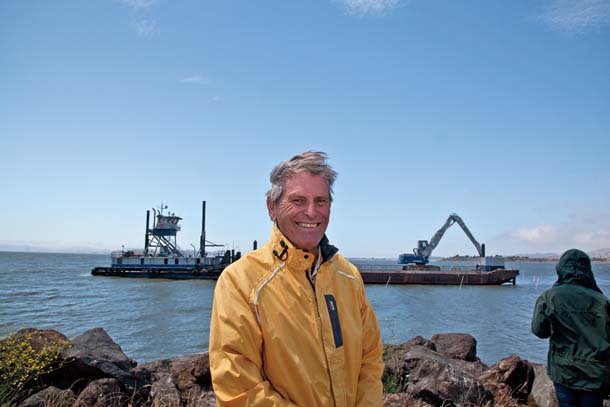
- Bud Abbott has built oyster reefs in Marin and Berkeley. Photo by Gwendolyn Meyer.
At the crack of dawn on June 24, working conditions for oyster restoration didn’t look promising. Bud Abbott woke to small craft warnings and increasing winds. The Bay horizon recalled an Ansel Adams photograph–all black, white, and silver–without a hint of color. “We’re good to go,” the self-proclaimed pointy-head fish scientist turned oyster reef builder kept saying over his cell phone to caller after caller. He couldn’t cancel. Jerico Products, which mines oyster shell deposits in the Bay, had donated a very big, very expensive tug, crane, and barge combo for the day. Abbott had to make the most of it.

- Just off the Berkeley Marina, a crane installs pallets of empty oyster shells where native oysters can settle and create new reefs. Photo by Gwendolyn Meyer.
Despite the weather, Abbott and his team managed to anchor 26 wooden pallets, each loaded with 200 pounds of oyster shell, to the gelatinous Bay floor near the Berkeley Marina. Abbott expects 100,000 oyster spat (young) to settle on the shells, along with a “halo” of seaweed and various other organisms. “Native oysters are a keystone species, because their structural features enable other creatures to live around them,” he says.
Olys, as some call our small, brown, native Olympia oysters, don’t build the big 3-D reefs that Eastern and Japanese oysters do. Their habitats here are more like beds than reefs. But they do pile up one on top of the other, and as such provide more of that natural hard substrate that is relatively scarce here. According to Chela Zabin, a coauthor of the shellfish research cited in the subtidal goals, the best conditions for oysters are in the salty waters of the central Bay, ranging from the west side between Brisbane’s Oyster Point and Marin’s Point San Quentin to the east side between Alameda and Richmond.
In their restoration experiments, Abbott and volunteers from groups such as Save the Bay and The Watershed Project have tried everything from hanging mesh bags of oyster shells off docks to dangling them from buoys at the Marin Rod & Gun Club.
Abbott is less interested in supplying local oysters for San Francisco’s infamous “hangtown fry” breakfast than he is in providing good Bay habitat in a watershed where most salmon restoration has happened upstream. Studies suggest that only 50 percent of salmon leaving the Bay have anything in their stomachs. Abbott likens the oyster reef and eelgrass to the string of McDonald’s along I-5. “Everyone has to eat on a journey. We want to put a reef here and there, so salmon can come out in good condition, fit and fat enough for life in the ocean,” he says.
By September, Abbott had found a way to get more tangible evidence that his subtidal ecosystem engineering efforts might be helping the chinook. Linking up with salmon tracking projects supported by federal fish and wildlife interests and Bay dredgers, he placed an acoustic listening device on the Berkeley reef. One day soon, he hopes to hear a ping from a tagged salmon stopping by for a nibble during its migration out to sea.
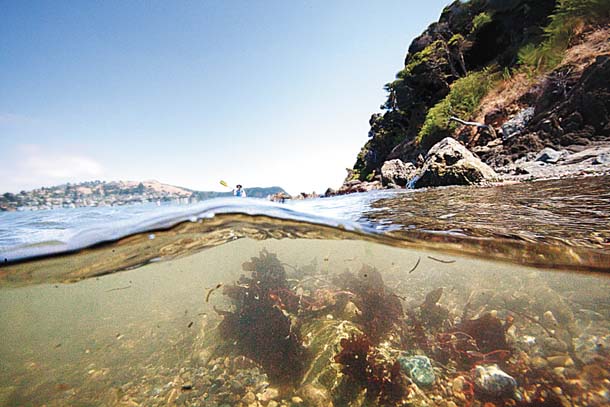
- A kayaker paddles over seaweed-adorned rocks. Photo: Lorenz-Avelar.com.
Of course, all these installations, oysters or eelgrass, even the mud and sand itself, are ephemeral. In the subtidal, water moves everything around. So efforts to protect and restore such habitats are challenging–and necessarily adaptive and iterative. Contributors to the subtidal goals project embrace this challenge by proposing a living shorelines approach with soft edges, fluid habitat boundaries, and special attention to connections between uplands, wetlands, mudflats, and the Bay’s deeper areas.
They hope their final report, what BCDC staffer Brenda Goeden calls “the latest and greatest of what we know scientifically about the subtidal environment,” will fuel research and restoration over the next five decades.
“Restoring the function of these foundational ecosystems is critical as we grapple with the legacy of the past, in terms of pollution and bay fill, and the complexity of the future with climate change and sea level rise,” Latta says. “We can either watch it all get destroyed, or we can spend our days trying to learn more about it and put it back. I’ve seen small projects result in great benefits. I’ve seen volunteers, bystanders, walkers get really excited about this connection to their Bay.”

.jpg)
